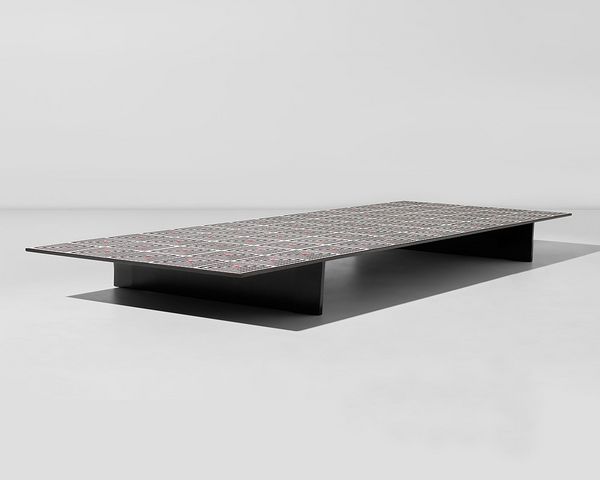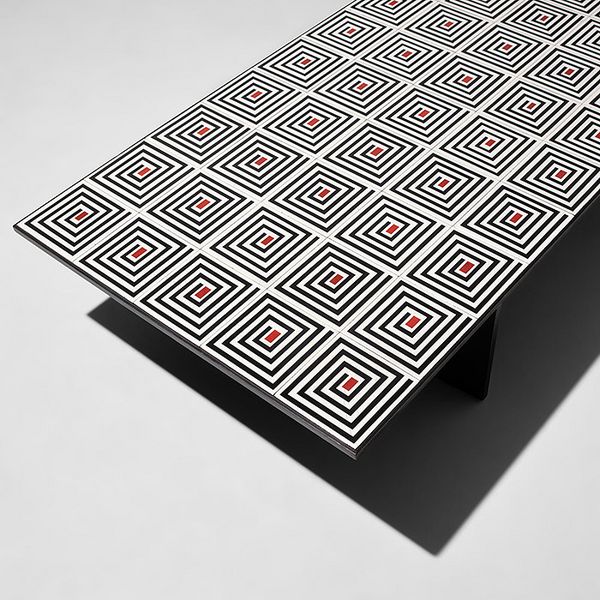Joaquim Tenreiro and Regina Bolonha, Unique coffee table, circa 1957. Design London.
By André Visockis
Rediscovered in recent years, the present unique coffee table designed by Joaquim Tenreiro in the late 1950s, emerges as one of the most extensively documented pieces from the designer’s oeuvre. The unprecedented scale as well as the 70 hand-painted tiles that lay across the top, made it a truly distinctive piece already at its conception.
The table has a remarkable provenance, passing through three generations of the Profili family to the grandchildren of Arturo and Enrica Profili. As many other Italians, they came to Brazil in the post-war years and were an essential influence on São Paulo's cultural development at that time. Mr. Profili arrived in Brazil in 1948 as a journalist to work at the newspaper 'O Fanfulla'. Well connected, he was integral to the foundation of São Paulo's Bienal de Artes, and, as its general secretary, welcoming foreigners was an important part of his duties. On the second edition of the Bienal, in 1953, there was a room dedicated to showcasing the work of Walter Gropius, who stayed in town for a few months. Profili and Gropius immediately bonded, and the Swiss architect was soon creating the conceptual sketches for Arturo’s residence in the São Paulo neighbourhood of Morumbi, one block away from Lina Bo Bardi's iconic ’Casa de Vidro.’ Arturo then hired his friend and renowned architect Oswaldo Bratke to execute Gropius’ designs.
By the late 1950s, the home was constructed and urgently in need of furnishings. Bratke selected several pieces of furniture that were on the showroom floor of Tenreiro’s shop, ready to be delivered. This coffee table was amongst them and remained in the family’s possession when they moved back to Italy in 1962. When the Profilis relocated back to Brazil in 1965, in the town of Itapecerica da Serra, the table’s rectilinear form fit easily into their newly designed home which was influenced by the vernacular ‘Bandeirista’ architecture style with its typical square and rectangular floor plans.
The present unique coffee table in the Profili’s house, Itapacerica da Serra, Brazil, 1970. Photo: Private family archive.
The coffee table can be seen in archival photographs from Tenreiro's store in São Paulo and it is also present in the cover of the seminal book 'Madeira, Arte e Design'. This publication, though modest in size, holds immense significance in comprehending Tenreiro’s way of thinking and approach to creating design as well as artworks.
The tiles were hand-painted by the artist Regina Bolonha. It is unknown whether the theme was proposed by Tenreiro or by Bolonha, but there is no doubt that Tenreiro created the wood structure to specifically highlight the tiles’ composition. This is evidenced by the short, bevelled feet and the dark frame enclosing the tiles matching the color and width of the painted motif, creating a perfectly seamless and harmonious composition. Despite the table’s visual lightness and simplicity, there is no shortage of technical consideration in its construction; Tenreiro was, first and foremost, an extremely skilled carpenter, and it was this mastery in craftsmanship that enabled him to become one of Brazil’s most important modern designers.
The present unique coffee table in Profili’s house, Itapecerica da Serra, Brazil, 1970. Photo: Private family archive.
Joaquim Tenreiro and Regina Bolonha, Unique coffee table, circa 1957 (detail). Design London.
Discover More from Design London >
Recommended Reading
The Emergence of the Master: Ettore Sotsass >
Beauty Suspended in Time: Shiro Kuramata >
Antiquity Made Modern: Diego Giacometti >
Elevation of the Human Spirit through Postmodern Design: Alessandro Mendini >



